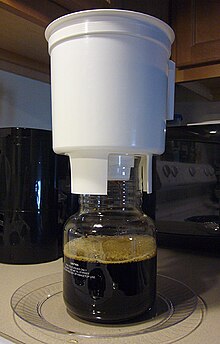Cold brew coffee: Difference between revisions
| Line 17: | Line 17: | ||
As the coffee beans in cold water extract coffee never come into contact with heated water, the process of leaching flavor from the beans produces a different chemical profile from conventional brewing methods.<ref>{{cite web|title=Coffee, without the heat|author=Jon Bonné|publisher=TODAY|date=August 20, 2004|access-date=Oct 7, 2015|url=http://www.today.com/id/5728227#.Vb8zifyweUk}}</ref> Coffee beans contain a number of constituents, such as caffeine, oils, and fatty acids, which are highly soluble at high temperatures. By brewing the coffee at lower temperatures, many of these solubles do not completely dissolve, resulting in lower acidity and lower caffeine content when brewed in equal volume.<ref>{{cite web|title=Why you should stop cold-brewing, and use the Japanese Iced Coffee Method.|author=Peter Giuliano|publisher=Pax Coffea.|url=http://petergiuliano.tumblr.com/post/22177089634/why-you-should-stop-cold-brewing-and-use-the|access-date=Nov 6, 2015}}</ref><ref>{{cite web|title=Does Cold Brew Coffee Have More Caffeine than Hot Coffee?|publisher=Coffee Chemistry|access-date=Nov 6, 2015|url=http://www.coffeechemistry.com/quality/brewing/does-cold-brew-coffee-have-more-caffeine-than-hot-coffee}}</ref> |
As the coffee beans in cold water extract coffee never come into contact with heated water, the process of leaching flavor from the beans produces a different chemical profile from conventional brewing methods.<ref>{{cite web|title=Coffee, without the heat|author=Jon Bonné|publisher=TODAY|date=August 20, 2004|access-date=Oct 7, 2015|url=http://www.today.com/id/5728227#.Vb8zifyweUk}}</ref> Coffee beans contain a number of constituents, such as caffeine, oils, and fatty acids, which are highly soluble at high temperatures. By brewing the coffee at lower temperatures, many of these solubles do not completely dissolve, resulting in lower acidity and lower caffeine content when brewed in equal volume.<ref>{{cite web|title=Why you should stop cold-brewing, and use the Japanese Iced Coffee Method.|author=Peter Giuliano|publisher=Pax Coffea.|url=http://petergiuliano.tumblr.com/post/22177089634/why-you-should-stop-cold-brewing-and-use-the|access-date=Nov 6, 2015}}</ref><ref>{{cite web|title=Does Cold Brew Coffee Have More Caffeine than Hot Coffee?|publisher=Coffee Chemistry|access-date=Nov 6, 2015|url=http://www.coffeechemistry.com/quality/brewing/does-cold-brew-coffee-have-more-caffeine-than-hot-coffee}}</ref> |
||
Additionally, the practice of serving cold brew coffee on nitro tap, similar to how a porter or stout |
Additionally, the practice of serving cold brew coffee on nitro tap, similar to how a porter or stout would be served in a bar, has risen in popularity. The practice should be done using strictly nitrogen, a non-water soluble gas, and not using a typical "beer gas," or 75% CO2/25% N mixture. Using pure nitrogen will ensure two things: that the coffee does not go stale once oxidizing with the CO2 and that a smooth flavor profile and aroma is released as the nitrogen evaporates from the coffee once poured. The alternative, using CO2, will result in a mouthy or soda-like texture and feel in consumption and rob the coffee of its' smooth, lager-like crispness and finish.<ref>{{cite web|title=Trident Cold Brew Coffee on Nitro Tap; San Diego, CA's premier small batch Cold Brew Coffee|author=Eric Johnson & Keegan Wetzel, Owners, Trident Coffee, LLC|access-date=Jun 20, 2016|url=http://www.tridentcoffee.com/}}</ref> |
||
==See also== |
==See also== |
||
Revision as of 19:12, 20 June 2016

Cold brew, or cold water extract, refers to the process of steeping coffee grounds in room temperature or cold water for an extended period. Cold brew coffee is not to be confused with iced coffee, which generally refers to coffee that is brewed hot and then chilled by pouring over or adding ice, though iced coffee can refer to cold brew coffee served on ice.
Process

The cold water extract process requires grinding: coarse-ground beans are soaked in water for a prolonged period of time, usually 12 hours or more.[citation needed] The water is normally kept at room temperature, but chilled water can also be used. The grounds must be filtered out of the water after they have been steeped using a paper coffee filter, a fine metal sieve, a French press or felt. The result is a coffee concentrate that is often diluted with water or milk, and can be served hot, over ice, or blended with ice and other ingredients such as chocolate.
“Kyoto style” cold brew refers to a unique process in which water is dripped through coffee grounds at room temperature over the course of many hours.[1]
Cold brew tea is a similar process using tea as opposed to coffee.[2]
Purpose
As the coffee beans in cold water extract coffee never come into contact with heated water, the process of leaching flavor from the beans produces a different chemical profile from conventional brewing methods.[3] Coffee beans contain a number of constituents, such as caffeine, oils, and fatty acids, which are highly soluble at high temperatures. By brewing the coffee at lower temperatures, many of these solubles do not completely dissolve, resulting in lower acidity and lower caffeine content when brewed in equal volume.[4][5]
Additionally, the practice of serving cold brew coffee on nitro tap, similar to how a porter or stout would be served in a bar, has risen in popularity. The practice should be done using strictly nitrogen, a non-water soluble gas, and not using a typical "beer gas," or 75% CO2/25% N mixture. Using pure nitrogen will ensure two things: that the coffee does not go stale once oxidizing with the CO2 and that a smooth flavor profile and aroma is released as the nitrogen evaporates from the coffee once poured. The alternative, using CO2, will result in a mouthy or soda-like texture and feel in consumption and rob the coffee of its' smooth, lager-like crispness and finish.[6]
See also
References
- ^ http://tmagazine.blogs.nytimes.com/2010/07/29/ristretto-kyoto-to-stay/?_r=0#
- ^ Peters, A. Brewing Makes the Difference. 14th Colloquium of Association for Science and Information on Coffee. Archived from the original (PDF) on 5 November 2014. Retrieved 5 November 2014.
{{cite conference}}: External link in|conferenceurl=|conferenceurl=ignored (|conference-url=suggested) (help) - ^ Jon Bonné (August 20, 2004). "Coffee, without the heat". TODAY. Retrieved Oct 7, 2015.
- ^ Peter Giuliano. "Why you should stop cold-brewing, and use the Japanese Iced Coffee Method". Pax Coffea. Retrieved Nov 6, 2015.
- ^ "Does Cold Brew Coffee Have More Caffeine than Hot Coffee?". Coffee Chemistry. Retrieved Nov 6, 2015.
- ^ Eric Johnson & Keegan Wetzel, Owners, Trident Coffee, LLC. "Trident Cold Brew Coffee on Nitro Tap; San Diego, CA's premier small batch Cold Brew Coffee". Retrieved Jun 20, 2016.
{{cite web}}: CS1 maint: multiple names: authors list (link)
External links
![]() Media related to cold brew at Wikimedia Commons
Media related to cold brew at Wikimedia Commons
